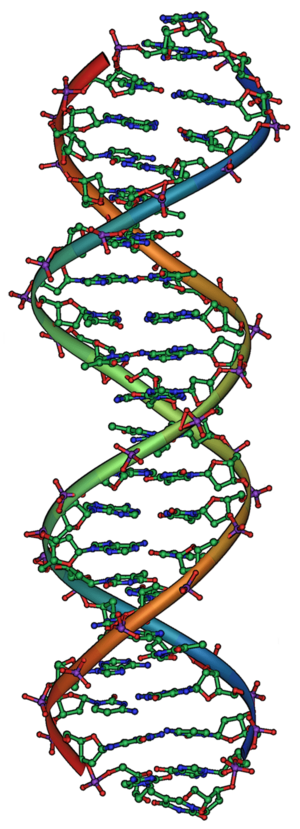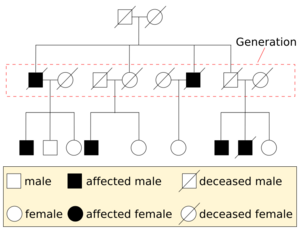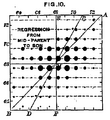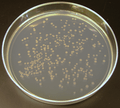Genetics facts for kids

Genetics is a branch of biology. It's the science that studies heredity, which is how living things pass on their features and traits to their children. This includes looking at genes, which are like instruction manuals inside our bodies. In labs, scientists study genetics by carefully breeding organisms and then looking at their offspring. Simply put, genetics is about how parents give some of their characteristics to their children. It's a very important part of biology and helps us understand how evolution works.
People have known for a very long time, even before history was written down, that living things inherit traits from their parents. They used this knowledge to make better crop plants and animals through selective breeding. But the modern science of genetics, which tries to truly understand how inheritance works, began with Gregor Mendel in the mid-1800s. Even though he didn't know exactly what genes were made of, Mendel noticed that organisms get traits through specific "units" of inheritance. We now call these units genes.
Contents
What is DNA and How Does it Work?
All living things are made of tiny parts called cells. Inside each cell are long, complex molecules called DNA. DNA stores all the information that tells a cell how to build and operate a living thing. Small sections of this information, which give instructions for one specific feature – like red hair, blue eyes, or being tall – are known as genes.
Every cell in a living thing has the same DNA. However, only certain parts of the DNA are used in each cell. For example, genes that tell how to make parts of the liver are turned off in the brain. Which genes are used can also change over time. For instance, many genes are active in a baby early in pregnancy but are not used later on.
A living thing gets two copies of each gene, one from its mother and one from its father. There can be different versions of each gene, which give different instructions. For example, one version might lead to blue eyes, while another might lead to brown eyes. These different versions are called alleles of the gene.
Since a living thing has two copies of each gene, it can have two different alleles at the same time. Often, one allele is dominant. This means the living thing will show the trait of that dominant allele, as if it only had that one. The allele that isn't expressed is called recessive. Sometimes, you get a mix between the two possibilities. In that case, the two alleles are called co-dominant.
Most features you see in a living thing are influenced by many genes. Also, many genes can have multiple effects on the body because their function might work differently in various tissues. When a single gene has multiple effects, it's called pleiotropism. The complete set of genes an organism has is called its genotype. The total effect of these genes on the body, or what you can actually see, is called the phenotype. These are very important words in genetics.
A Brief History of Genetics
Early Ideas About Heredity
Humans started breeding animals like dogs and farm animals a very long time ago, even before they began farming. We don't know exactly when people first thought about heredity as a scientific puzzle. Ancient Greeks, especially Aristotle, studied living things and had ideas about reproduction and how traits were passed down.
Perhaps the most important idea before Mendel came from Charles Darwin. He had a theory called pangenesis. One part of his idea was correct: that lasting units of heredity were passed from one generation to the next. However, his other idea, that these units were refilled by tiny particles from body tissues, was wrong. Darwin was right about one thing: whatever causes evolution must involve heredity. So, understanding genetics is key to understanding evolution. It took many years for genetics and evolution to fully connect, leading to the Modern evolutionary synthesis.
Gregor Mendel's Discoveries
The basic rules of genetics were first found by a monk named Gregor Mendel around 1865. For thousands of years, people had tried to understand how traits are passed from parents to children. But Mendel's work was special because he planned his experiments very carefully.
Mendel studied how traits were passed on in pea plants. He started with plants that always produced the same traits, and he looked at features that were clearly one way or another (like either tall or short). He grew many plants and wrote down his results using numbers. He also used special crosses to find out how many recessive traits were present.
Mendel explained his results with two scientific laws:
- 1. Factors (which we now call genes) usually come in pairs in regular body cells. But they separate when sex cells (called gametes) are made. These factors control an organism's traits and are inherited from its parents. When gametes are formed through a process called meiosis, the two factors separate, and each gamete gets only one. Mendel called this the Law of Segregation.
- 2. Alleles for different genes separate independently of each other when gametes are formed. He called this the Law of Independent Assortment. So, Mendel thought that different traits are inherited separately. We now know this is only true if the genes are not on the same chromosome, meaning they are not linked together.
Mendel's laws helped explain what he saw in his pea plants. Later, scientists found that his laws also applied to other living things, including humans. Mendel's work on pea plants helped create the field of genetics. His contributions weren't just the basic rules he found. Mendel's careful control of his experiments and his focus on numerical results set a high standard for future scientific work. Over the years, scientists have changed and improved Mendel's ideas. However, the science of genetics wouldn't be possible today without the early work of Gregor Mendel.
How Cells and Genes Connect
After Mendel's work, scientists learned a lot about cytology, which is the study of cells. Discoveries about the cell's nucleus and how cells divide were very important for understanding Mendel's ideas.
- In the late 1800s, scientists like Walther Flemming and Eduard Strasburger described how chromosomes behave when cells divide (a process called mitosis).
- Wilhelm Roux realized that chromosomes are like linear structures. When they split into two equal halves, it ensures each new cell gets the same set of chromosomes. This showed that chromosomes carry the information for heredity.
- Hugo de Vries suggested that traits are inherited through "particles," which he called (pan)genes.
- Later, Theodor Boveri and Walter Sutton connected the behavior of chromosomes to Mendel's results. They suggested that chromosomes are the units of heredity. This idea is known as the Sutton–Boveri hypothesis.
These discoveries in cell biology, combined with Mendel's rediscovered ideas, led to a new field called cytogenetics (cyto = cell; genetics = heredity). This field continues to be important today.
Mendel's Work is Rediscovered
In the 1890s, several biologists started doing breeding experiments. They soon found results similar to Mendel's, even before they read his papers. Carl Correns and Hugo de Vries were the main scientists who rediscovered Mendel's writings and laws. Both gave Mendel credit for his earlier work. Although de Vries later lost interest in Mendel's ideas, other biologists continued to build genetics into a full science.
Mendel's results were confirmed, and scientists soon figured out genetic linkage (how genes on the same chromosome are inherited together). William Bateson did a lot to spread Mendel's theory in the early days. The word genetics and other terms we use today came from Bateson.
Tools for Studying Genetics
Mutations: Changes in DNA
Sometimes, during the process of DNA replication (when DNA makes copies of itself), mistakes happen. These mistakes are called mutations. Mutations can change the phenotype of an organism, meaning how it looks or functions. This usually affects the organism's fitness, which is its ability to live and reproduce successfully.
Normally, mistakes are very rare – about 1 error for every 10 to 100 million DNA building blocks. This is because DNA has "proofreading" abilities. However, some viruses have much higher error rates because their DNA or RNA copying tools don't have this proofreading ability.
Things that increase the rate of changes in DNA are called mutagenic. For example, certain chemicals can cause errors in DNA copying. UV radiation (like from the sun) can also cause mutations by damaging the DNA structure. DNA can also be damaged naturally, and cells have ways to repair these damages. But sometimes, the repair doesn't perfectly restore the original DNA sequence.
In organisms that use chromosomal crossovers to swap DNA and mix genes, mistakes during meiosis (cell division for reproduction) can also cause mutations. These errors can lead to big changes in the DNA sequence, such as duplications (extra copies of genes), inversions (parts of DNA flipped around), or deletions (missing parts of DNA). Sometimes, whole parts of different chromosomes can be accidentally swapped, which is called translocation.
Punnett Squares: Predicting Traits
Developed by Reginald Punnett, Punnett squares are tools used by biologists to figure out the chance of offspring having a certain genotype (genetic makeup).
| Maternal | |||
|---|---|---|---|
| B | b | ||
| Paternal | B | BB | Bb |
| b | Bb | bb | |
Let's say 'B' stands for the allele for black hair and 'b' for white hair. If two parents both have one of each allele (Bb), the Punnett square shows their children would have a 25% chance of having two white hair alleles (bb), a 50% chance of having one of each (Bb), and a 25% chance of having only black hair alleles (BB).
Pedigree Charts: Family Trees of Traits
Geneticists (scientists who study genetics) use pedigree charts to keep track of traits in a family. By looking at these charts, geneticists can study how a trait is passed down from one person to another through generations.
Pedigree charts can also help geneticists predict how traits might be passed to future children in a family. For example, genetic counselors are experts who help families dealing with genetic diseases. As part of their job, they create pedigree charts for the family. These charts help them understand how a disease might be inherited.
Twin Studies: Nature vs. Nurture
Since we can't do breeding experiments with humans, human genetics must be studied in other ways. One way is by studying the human genome (all our DNA). Another, much older way, is to study twins.
Identical twins are like natural clones. They have the exact same genes. Studying them can help us figure out how much heredity (our genes) influences individual people. Twin studies have shown interesting things. If we list different traits, we find that they are influenced by heredity to different degrees. For example:
- Eye color: Almost entirely inherited.
- Weight, height: Partly inherited, partly influenced by environment (like diet and lifestyle).
- Which language a person speaks: Entirely environmental (learned from surroundings).
These studies work by comparing a group of identical twins with a group of fraternal twins (who are like regular siblings but born at the same time). Scientists measure various traits in both groups and then use statistical analysis. This tells them how much a trait is inherited. Traits that are partly inherited will be much more similar in identical twins. These studies can even compare identical twins raised together with identical twins raised apart. This helps scientists understand how much different environments can change the outcomes for people with the same genes.
The first person to do twin studies was Francis Galton, who was Charles Darwin's half-cousin and a founder of statistics. He tracked twins throughout their lives, taking many measurements. However, modern twin studies, which truly understood the genetic differences between identical and fraternal twins, didn't appear until the 1920s.
Genes and Development
Gene Expression: DNA to Protein
Gene expression is the process where the information in a gene (the sequence of DNA) is used to create a working product, like a protein or RNA. The basic idea is that DNA is first copied into RNA, and then this RNA is translated into proteins. Proteins build many structures and act as all the enzymes inside a cell or an organism.
Several steps in gene expression can be adjusted or "tuned." This includes both the copying (transcription) and translating stages, as well as how the final protein folds. Gene regulation turns genes on and off, which controls how cells become specialized (like a muscle cell vs. a skin cell) and how an organism develops its shape (called morphogenesis). Gene regulation can also be a basis for evolutionary change: controlling when, where, and how much a gene is expressed can greatly affect an organism's development. A single gene's expression can vary a lot in different tissues, which is called pleiotropism.
A very important modern discovery is Alternative splicing. This is a process where a single gene can be used to create many different versions of proteins. For example, one specific gene in the fruit fly (Drosophila) can be alternatively spliced into 38,000 different types of mRNA.
Epigenetics: Beyond the DNA Sequence
Epigenetics is the study of changes in gene activity that are not caused by changes in the actual DNA sequence. It's about how genes work and produce their phenotypic effects.
These changes in gene activity can last for the rest of a cell's life and can even be passed down through many generations of cells during cell divisions. However, the underlying DNA sequence of the organism itself doesn't change. Instead, other factors cause the organism's genes to behave (express themselves) differently.
Hox genes are a group of genes whose proteins attach to specific control areas of other genes. These target genes then either activate or stop cell processes to guide the final development of the organism.
Extranuclear Inheritance: Genes Outside the Nucleus
Most inheritance happens through chromosomes inside the cell nucleus, coming from both parents. But there are some types of heredity that occur outside the cell nucleus.
Organelle Heredity
Mitochondria and chloroplasts (in plants) have some of their own DNA. Their makeup is determined by genes in the main chromosomes and genes within the organelle itself. Carl Correns found an example in 1908 with the four o'clock plant, Mirabilis jalapa, which has white, green, or mixed-color leaves. Correns discovered that the pollen had no effect on this inheritance. The leaf color is decided by genes in the chloroplasts.
Infectious Heredity
This type of inheritance is caused by a close relationship, either symbiotic (beneficial to both) or parasitic (one benefits at the other's expense), with a microorganism.
Maternal Effect
In this case, genes from the mother's gamete (egg cell) are copied. The products of these genes build up in the egg's cytoplasm and affect the early development of the fertilized egg. For example, the way a snail's shell coils (like Limnaea peregra) is determined this way.
A very important example of maternal effect is seen in the fruit fly, Drosophila melanogaster. The protein products of maternal-effect genes activate other genes, which then activate even more genes. This work led to a Nobel Prize in Physiology or Medicine in 1995.
Modern Genetics: New Discoveries
Much of today's research combines genetics with cell biology and molecular biology. Some topics that have won Nobel Prizes in either chemistry or physiology include:
- Alternative splicing: where one gene can make many different, but related, protein products.
- Genomics: the study of the entire set of genes (genome) of an organism, including its sequence, function, and structure.
- Genetic engineering: changing an organism's genes using special biotechnology tools.
- Mobile genetic elements: types of DNA that can move around within the genome.
- Horizontal gene transfer: when an organism gets genetic material from another organism without being its offspring.
Genetics of Human Behavior
Many well-known human behaviors and disorders have a genetic part. This means that our genes partly cause the behavior or make it more likely to happen. Examples include:
Normal behaviors are also greatly influenced by heredity:
- Learning and thinking ability
- Personality
Related pages
- ENCODE: a full analysis of the human genome
- Gene therapy
Images for kids
-
Human height is a trait with complex genetic causes. Francis Galton's data from 1889 shows the relationship between offspring height as a function of mean parent height.
-
Walther Flemming's 1882 diagram of eukaryotic cell division. Chromosomes are copied, condensed, and organized. Then, as the cell divides, chromosome copies separate into the daughter cells.
-
Thomas Hunt Morgan's 1916 illustration of a double crossover between chromosomes.
-
Siamese cats have a temperature-sensitive pigment-production mutation.
-
Colonies of E. coli produced by cellular cloning. A similar methodology is often used in molecular cloning.
See also
 In Spanish: Genética para niños
In Spanish: Genética para niños












